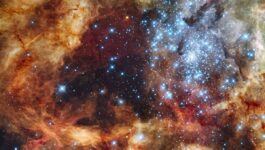
A giant star cluster regularly expels suns into the Tarantula
The R136 cluster contains the most massive star ever observed.
© Nasa / ESA F. Paresce (INAF-IASF, Bologna, Italy), R. O'Connell (University of Virginia, Charlottesville) & Wide Field Camera 3 Science Oversight Committee
R136 doesn't have the prettiest name among star clusters. We will prefer it the Pleiades Or the double cluster of Perseus. It is nevertheless famous among professional and amateur astronomers.
The entire cluster “weighs” 450,000 solar masses, but contains “only” 10,000 suns! He therefore saw the birth of excessively massive stars, so much so that some still raise questions today about the limits that these otherworldly bodies can reach.
And it is precisely another world here, and even another galaxy called the Large Magellanic Cloud, so named for having helped the latter to find its way during its legendary navigation in the Southern Hemisphere. And more precisely, of a gigantic and sumptuous star nursery nebula called the Tarantula:
Tarantula Nebula seen by the James Webb Space Telescope. The blue stars in the center belong to the famous cluster R136 discussed in the article.
© NASA / ESA
The cluster R136 contains the most massive stars known
This cluster hosts in particular R136 a1, which deserves a better name – you can suggest one in the comments – as it is exceptional, because it weighs between 150 and 300 solar masses. It is quite simply the most massive star ever observed. It could even challenge astrophysicists' knowledge of the laws underlying the balance of stars (in the sense that the balance between radiative pressure due to heat and gravitational pressure, in the opposite direction, is precarious to say the least) . Its surface temperature is 10 times higher than that of our nearby sun and its luminosity is millions of times stronger.
These type O stars are blue, which is always the case from a surface temperature of approximately 10,000 °C.
Tarantula Nebula, then zoom to R136, then to R136 a1, a2 and a3.
© ESO / P. Crowther/CJ Evans – The young cluster RMC 136a
This cluster expels giant stars at more than 100,000 km/h
The study published on October 9, 2024 in Nature reports a remarkable discovery by a doctoral student in astrophysics. Indeed, this cluster twice ejected dozens of stars, around 55, the first time 1.8 million years ago and the last time 200,000 years ago.
Artistic illustration of stars ejected from the R136 cluster.
© Artistic impression of the star cluster R136 aDanielle Futselaar, James Webb Space Telescope/NIRCam – NASA, ESA, CSA and STScI
We note that these two epochs correspond for the oldest to the age of the cluster and for the most recent to the age of extremely massive stars like R136a. However, the authors of the article believe that the second event is linked to the interaction with a cluster discovered in 2012, with which it will merge. There is also a notable difference: the first ejection was in random directions, while the second took a preferred direction. The calculated speeds are greater than 100,000 km/h, which remains quite modest when we think of the path of the Sun in the Milky Way, which is around 800,000 km/h without it being enough to expel us from the Galaxy.
Giant stars of this type (O) ionize their environment and explode in supernova
We will end by specifying that these movements, as rapid or astonishing as they seem, are in fact quite common in the Universe, where everything is in motion and has a speed relative to some place. Star nurseries often see their offspring emerge from the cocoon where they were formed. It's a bit like a mother who ends up saying to the mother and the baby: “It’s okay, you can leave the room!”
But what is interesting here is that it is a cluster with particular characteristics: these giant stars will explode in a few thousand or millions of years in supernovae after having ionized their environment. This type of past event was probably decisive in the history of the Universe, and therefore in ours.





